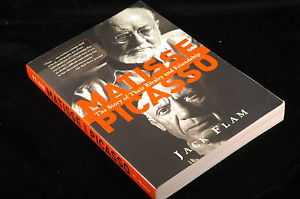From Jack D. Flam’s Matisse and Picasso: The Story of Their Rivalry and Friendship (2003):

‘Picasso characterized the arbitrariness of representation in his Cubist paintings as resulting from his desire for “a greater plasticity.” Rendering an object as a square or a cube, he said, was not a negation, for “reality was no longer in the object. Reality was in the painting. When the Cubist painter said to himself, ‘I will paint a bowl,’ he set out to do it with the full realization that a bowl in a painting has nothing to do with a bowl in real life.” Matisse, too, was making a distinction between real things and painted things, and fully understood that the two could not be confused. But for Matisse, a painting should evoke the essence of the things it was representing, rather than substitute a completely new and different reality for them. In contract to Picasso’s monochromatic, geometric, and difficult-to-read pictures, Matisse’s paintings were brightly colored, based on organic rhythms, and clearly legible. For all their expressive distortions, they did not have to be “read” in terms of some special language or code.’
Related: On the modernist break with representation and other artistic values. ESEADE University lecture:
“Modern art” being what it is, how can we conceive standards of competition between its “practitioners”? Did they compete in any way but in achieving notoriety? A painter of great skill like Picasso differs from Matisse, a painter of great imagination only by chance. The latter sought beauty and was spiritual but the former, in need of a girlfriend, would paint a giant portrait of his penis and hang it in the window. (Now I expect some readers will argue that Picasso had more imagination.) Cubism to me is like Schoenbergian atonal music, art conceived from a matrix. Is that art?
The best discussion of modern art (save our august Stephen Hicks [boson] commentaries) is in Jacques Barzun’s FROM DAWN TO DECADENCE a volume on the degradation of culture during the 20th century. Mr. Barzun just died at the age of 107 and had enough experience to cover the subject!